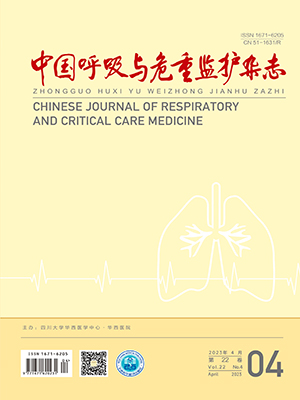| 1. |
Suter PM, Fairley B, Isenberg MD. Optimum end-expiratory airway pressure in patients with acute pulmonary failure. N Engl J Med, 1975, 292: 284-289.
|
| 2. |
Hickling KG. Reinterpreting the pressure-volume curve in patients with acute respiratory distress syndrome. Curr Opin Crit Care, 2002 , 8: 32-38.
|
| 3. |
Hickling KG. The pressure-volume curve is greatly modified by recruitment . A mathematical model of ARDS lungs. Am J Respir Crit Care Med, 1998, 158: 194-202.
|
| 4. |
Albaiceta GM, Taboada T. Parra D, et al. Tomographic study of the inflection points of the pressure-volume curve in acute lung injury. Am J Respir Crit Care Med, 2004, 170: 1066-1072.
|
| 5. |
陳宇清, 周新. 急性呼吸窘迫綜合征的壓力-容積曲線及其臨床應用. 中國呼吸與危重監護雜志, 2007, 6: 314-320.
|
| 6. |
LaFollette R, Hojnowski K, Norton J, et al. Using pressure-volume curves to set proper PEEP in acute lung injury. Nurs Crit Care, 2007, 12: 231-241.
|
| 7. |
·513· ? 2002-2009 Editorial Department of Chinese Journal of Respiratory and Critical Care Medicine. All rights reserved. Http://www.cjrccm.com 19 Rylander C, H gman M, Perchiazzi G, et al. Functional residual capacity and respiratory mechanics as indicators of aeration and collapse in experimental lung injury. Anesth Analg, 2004,98: 782-789.
|
| 8. |
Hickling KG. Best compliance during a decremental, but not incremental, positive end-expiratory pressure trial is related to open- Lung positive end-expiratory pressure. Am J Respir Crit Care Med, 2001, 163: 69-78.
|
| 9. |
Koefoed-Nielsen J, Andersen G, Barklin A, et al. Maximal hysteresis: a new method to set positive end-expiratory pressure in acute lung injury? Acta Anaesthesiol Scand, 2008 , 52 : 641-649.
|
| 10. |
Syring RS, Otto CM, Spivack RE, et al. Maintenance of endexpiratory recruitment with increased respiratory rate after salinelavage lung injury. J Appl Physiol, 2007, 102: 331-339.
|
| 11. |
, No.
|
| 12. |
Gattinoni L, Caironi P, Carlesso E. How to ventilate patients with acute lung injury and acute respiratory distress syndrome. Curr Opin Crit Care, 2005, 11: 69-76.
|
| 13. |
Toth I, Leiner T, Mikor A, et al. Hemodynamic and respiratory changes during lung recruitment and descending optimal positive end-expiratory pressure titration in patients with acute respiratory distress syndrome. Crit Care Med, 2007, 35: 787-793.
|
| 14. |
Borges JB, Okamoto VN, Matos GF, et al. Reversibility of lung collapse and hypoxemia in early acute respiratory distress syndrome. Am J Respir Crit Care Med, 2006, 174: 268-278.
|
| 15. |
Meier T, Luepschen H, Karsten J, et al. Assessment of regional lung recruitment and derecruitment during a PEEP trial based on electrical impedance tomography. Intensive Care Med, 2008, 34 : 543-550.
|
| 16. |
Henzler D, Pelosi P, Dembinski R, et al. Respiratory compliance but not gas exchange correlates with changes in lung aeration after a recruitment maneuver: an experimental study in pigs with saline lavage lung injury. Crit Care, 2005, 9: R471-R482.
|
| 17. |
Suarez-Sipmann F, B hm SH, Tusman G, et al. Use of dynamic compliance for open lung positive end-expiratory pressure titration in an experimental study. Crit Care Med, 2007 , 35: 214 -221.
|
| 18. |
邱海波, 許紅陽, 楊毅, 等. 呼氣末正壓對急性呼吸窘迫綜合征肺復張容積及氧合影響的臨床研究. 中國危重病急救醫學, 2004, 16: 993-204.
|
| 19. |
Grasso S, Terragni P, Mascia L, et al. Airway perssure-time curve porfile ( stress index ) detects tidal recruitment /hyperinflation in experimental acute lung injury. Crit Care Med, 2004 , 32: 1018 - 1027.
|
| 20. |
邱海波, 陳永銘, 楊毅, 等. 肺牽張指數指導不同原因急性呼吸窘迫綜合征復張后呼氣末正壓選擇的實驗研究. 中華外科雜志, 2006, 44: 1181-1184. 中國呼吸與危重監護雜志2009 年9 月第8 卷第5 期Chin J Respir Crit Care Med, September 2009, Vol.
|
| 21. |
Lambermont B, Ghuysen A, Janssen N, et al. Comparison of functional residual capacity and static compliance of the respiratory system during a positive end-expiratory pressure ( PEEP) ramp procedure in an experimental model of acute respiratory distress syndrome. Crit Care, 2008, 12: R91.
|
| 22. |
Tusman G, Suarez-Sipmann F, B hm SH, et al. Monitoring dead space during recruitment and PEEP titration in an experimental model. Intensive Care Med, 2006, 32: 1863-1871.
|
| 23. |
Carvalho AR, Jandre FC, Pino AV, et al. Positive end-expiratory pressure at minimal respiratory elastance represents the best compromise between mechanical stress and lung aeration in oleic acid induced lung injury. Crit Care, 2007, 11: R86.
|
| 24. |
Pássaro CP, Silva PL, Rzezinski AF, et al. Pulmonary lesion induced by low and high positive end-expiratory pressure levels during protective ventilation in experimental acute lung injury. Crit Care Med. , 2009, 37: 1011-1017.
|
| 25. |
Pelosi P, D′Onofrio D, Chiumello D, et al. Pulmonary and extrapulmonary acute respiratory distress syndrome are different. Eur Respir J, 2003, 42: 48s-56s.
|
| 26. |
Villar J. Positive end-expiratory pressure or no positive endexpiratory pressure: is that the question to be asked? Crit Care, 2003, 7: 192.
|




